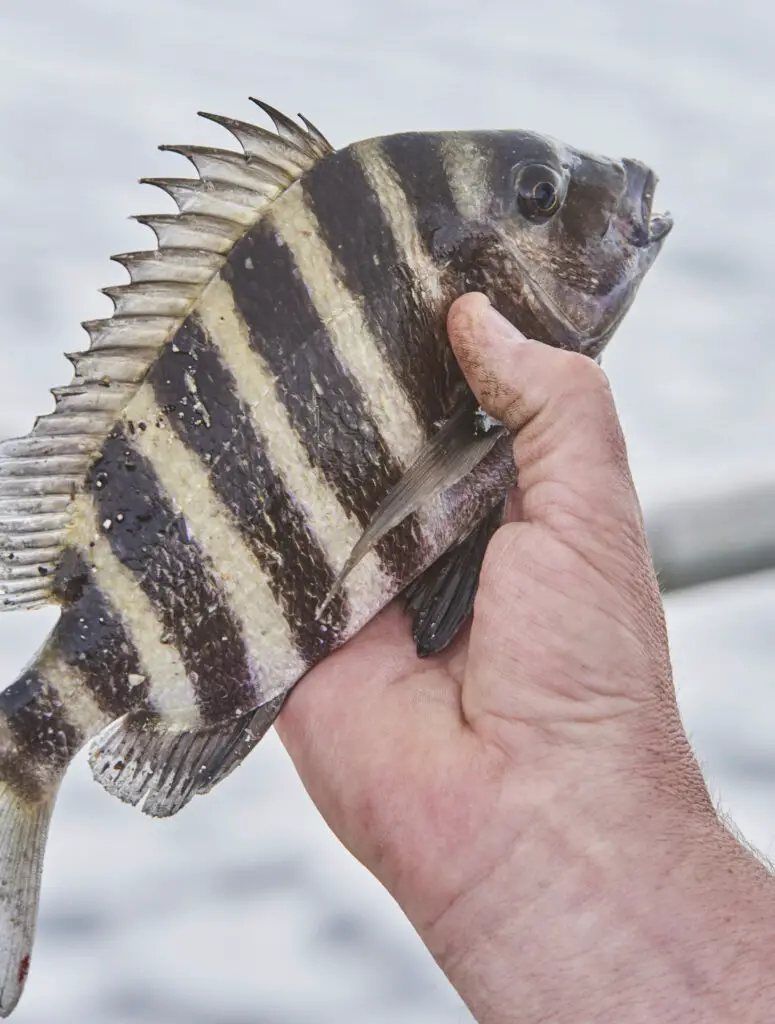As an Amazon Associate we earn from qualifying purchases.
A sheepshead is one of the most delicious marine fish known to mankind. However, with its excellent taste, it is also tedious to clean it and acquire its meat. In this article, let’s see how to clean sheepshead.
Contents
How to Clean Sheepshead
Unlike most fishes and other marine life that are quite direct to clean, it is a lengthy and challenging process to get sheepshead meat separated from its bones. It requires some precautions and fine technique to clean a sheepshead.
Tools Required
- A pair of gloves
- A sharp filet knife
- A cutting board
- A fish rag
Safety Precautions
- The spikes on the body of a sheepshead tend to be very hard, and it can even cause the knife cutting it to slip and cause injuries.
- To prevent this and get a proper grip on the fish, wear gloves, at least on the hand with which you will hold the fish.
- The knife you use should be sharp. A blunt knife can slip and lead to wastage of meat and injuries as well.
Step#1: Ensure the Fish Is Dead
The sheepshead is a fish that can survive for a considerable time even after being pulled out of water. Ensure that it’s dead by braining.
Poke your finger precisely at the meeting point of the fish’s spine and its head. This process also ensures that the fish doesn’t suffer during its cleaning process.
It makes the process safer, as the fish will not woggle when you begin to clean it.
Step #2: Drain the Blood
You can significantly enhance the taste of the fish by letting the blood inside it drain out. This process is called draining.
The heart of the sheepshead is located on top of its gills. You need to cut the arteries, which are located in the side of the heart, to drain out the blood.
Sometimes, you can choose to pull out the gill, which is not preferable but is less tedious.

Step #3: Gut the Fish
Once you have drained the blood, you can take some steps which help to preserve the fish better and make cutting it easier.
Take the gills out of the fish, preserving its integrity. The gill plate will serve as a guide to cut the fish later on and remember its position.
Step #4: Scale the Fish
Scaling the fish is an optional step, but it helps the spices permeate the fish and make it all the more delicious. Therefore, it is highly recommended.
Hold your knife with its pointed tip near the back of the fish. Make a small angle before you begin to scale the fish towards the head of the fish.
Make small and smooth movements. The movements should be in the way of sweeping on the surface of the fish.
This will ensure that the scales come out effectively, and you get the entirety of the meat for further cutting. Removing the scales also helps to cut the fish without damaging the knife blade.
Step #5: Begin to Cut
Once you have scaled the fish correctly, you can begin to cut the fish.
- Find the anal cavity of the fish as you will begin cutting from there. Starting from the anal cavity, make an incision towards the jaw of the fish.
- Make sure this incision is not too deep. A very deep incision can open up the organs of the fish.
- The gill plate of the fish is the part where you have to begin from. You will find it on anyone the sides of the head of the fish.
- Start cutting in a downward direction, starting from behind the gills.
- Make a triangular incision joining the bottom part of the lips, the gills, and the center of the sheepshead.
- Beside the dorsal vein of the sheepshead, there is a delicate membrane that runs downward, right along the backbone. Use this as a guide to cut along.
- Place your knife close to the backbone and prepare for a vertical cut. Turn your fish before inserting the blade to make cutting easier.
- Begin cutting the fish from the backbone towards the ribcage. The flesh will begin to come out loosely.
- Insert the knife completely inside the fish after passing it across the rib. Carefully take out the flesh without tampering with the skin in front of the tail.
- Cut and detach the fillet from every point where it is attached to the bones of the sheepshead. Start from the front and move backward.
- Overturn the fish and take out the flesh carefully from the other side as well.
- Put your fingers on the tail of the fillet and lay it on the chopping board with skin side down.
- Cut the skin carefully with a knife taking care that the red part of the flesh stays attached to the skin.
- Remember to remove the pin bone from every fillet you cut. Cut a little chunk out in line with the lateral part of each fillet.
Step #6: Clean the Fish
After the fillet has been completely cut and put in a container, you need to clean it properly to ensure no foreign materials remain on the fish.
Use lukewarm water to thoroughly wash the fillets and let them dry before you start cooking. You can also add some salt to the warm water you use for cleaning, this process is pretty helpful for cleaning milk bags as well.
Now, the sheepshead is perfectly clean and ready to be cooked. You can also refer to this video guide to get a better idea about the detailed process of cleaning a sheepshead.
Frequently Asked Question
Is It Difficult to Cut a Sheepshead at Home?
A sheepshead is different from other edible fish because of its structure and spines. Although the process is a bit tricky, knowing the proper techniques can help you cut it easily. Cutting sheepshead is definitely easier than turkey necks, and cleaning a grouse.
Conclusion
A sheepshead is an absolute delight to have on your dinner table, unless you burned your oven trying to cook it. Its spikes can make it a little difficult to cut. However, following proper safety precautions and cutting it with care can make the process simple.
